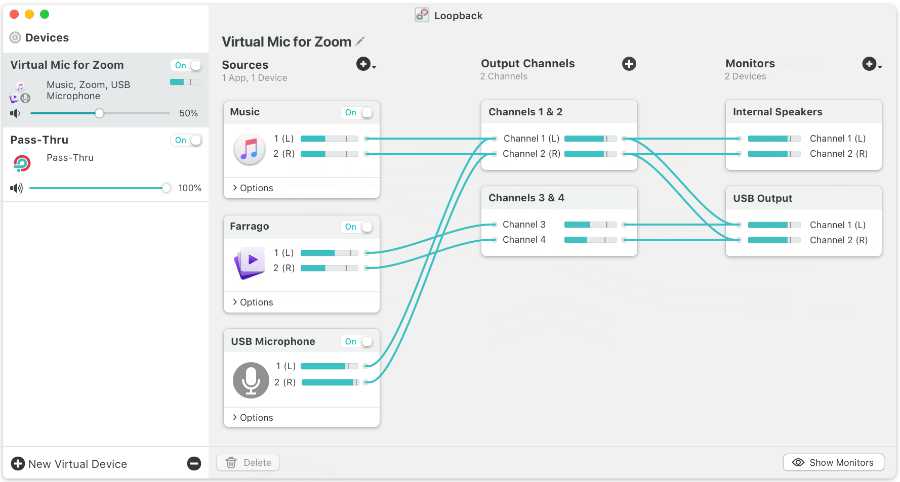
Tools that made Teaching 2020 possible: Loopback is a Mac software tool that creates a digital patch bay for audio. Without it I couldn’t get video to run live in the LMS I was using. It also made it possible to speak over the clips. Image courtesy Rogue Amoeba.
BitDepth#1282 for December 31, 2020
One characteristic of the first school term of 2020-2021 was how very different it was for almost everyone who was involved in it.
The common experience of hustling children to school and then heading off to work morphed into a home-based chaos that was as individual as the people who experienced it.
In just a few short days, we’ll be returning to that experience, definitely sadder, but absolutely a bit wiser. I’ve sifted through my own experiences to find some points worth sharing.
Even if you have enough space, you don’t have enough space.
From March, many of us were called on to compress school, work and home into a single building. Some already didn’t have enough space for living, far less working, and schooling.
Even if it was possible to send children to other family while working, for many that just moved the problem elsewhere.
This isn’t an easy challenge to surmount. I worked for decades to carve a functional and comfortable home office out of my living space, and I wasn’t ready when TT locked down in March.
Tools that made Teaching 2020 possible: On March 21, I bought Mpow’s EC3 gaming headset.
It was, quite possibly, the best thing I spent money on to help with online teaching.
It is comfortable, clear and has a tangle-free cable.
Some tools are important not because of special features, but because they eliminate hassles. I also paid for Flickr Pro to review student images because the ads in the free version made the process tedious.
Image courtesy Mpow.
This was the year of headphones.
Part of the problem is that living spaces aren’t designed to be co-working spaces.
Even when you create adequate physical space, there’s often audio overlap.
Some folks are very comfortable with in-ear headphones. I am not, nor am I a fan of the vagaries of computer microphones.
There are two teachers and two students in this household of three, so sound control – in an environment in which three concurrent classes occurred frequently – was enforced with over-ear headphones (cans, in audiophile parlance) and headsets with microphones.
It makes for a bulky tangle at times, but the payoff in comfort and audio quality in regular, extended use is significant.
We are all traumatised and coping.
There is no handbook to guide anyone through this. Every solution is worth a try, and every failure is a learning experience.
When I had to shift an in-person teaching experience to virtual in March, I froze up.
After some pointed administrative urging, I finally got started and after stumbling through the semester, I disassembled the course and reimagined it for September’s students.
There were things I clearly couldn’t do anymore.
Some elements required a personal investment to bridge the shortfalls of the learning platform and my needs.
To my surprise, the exercise, not unlike servicing a race car while it’s barrelling down the track, made the course better.
The radical rethink allowed me to consider the course material and requirements through a dramatically different lens, which improved several aspects of the teaching process.
Students are smart.
Sometimes dangerously so.
One teacher told me about a student who would disappear from class during question time. Internet would “drop” every time there was a possibility of being called on.
In my own classes, some students were ghosts.
One student attended class while driving (I insisted that he turn off video). At least two attended while at work.
When I assigned a portrait during class, I got a selfie in the office bathroom mirror a few minutes later. It was pretty good too.
Teaching was always a communal experience, and everyone knows that now.
Over the centuries that schooling has become entrenched as an institution, some presumptions have come to be understood as facts. Teachers teach, parents parent and students learn.
All that collapsed during Covid-19 and lockdowns created an experience that redrew those boundaries.
Teachers became collaborators, life coaches and crisis spotters as private life spilled into camera range.
Students pitched in to help with connectivity issues, passed along schoolwork and helped colleagues in private conversations.
Parents had to do…everything.
Knitting the frayed fabric of the education experience into something comprehensible was now a job for everyone and that may be the most important lesson for the education system after covid19.


